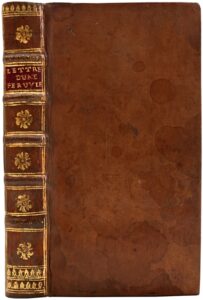À Peine, [1747].
12mo [141 x 72 mm] of (1) l. of title, viii pp., 337 pp. Bound in full glazed calf, spine ribbed and decorated with gilt fleurons, red morocco lettering piece, inner gilt border, red edges. Contemporary binding.
Quite rare first edition of one of the most famous literary books of the 18th century blacklisted on July 28th, 1765. Rahir, p. 17 ; Brunet II, 1690, Morgand & Fatout, 6146 ; Barbier, Dictionnaire des ouvrages anonymes, II, 1246 ; Debacker, 1131.
It is quoted by Edouard Rahir in La Bibliothèque de l’amateur in the chapter « Livres recherchés pour le texte » (Books sought-after for the text) (p. 17).
It was published in 1747, after the author made herself known with her letters about Voltaire with whom she took refuge in Cirey. Montesquieu’s Lettres persanes were a model to her.
A young Peruvian girl writes from Paris to a distant fiancé: arriving into a world that is unfamiliar to her, she entered it little by little, got to know the customs, to lêrn the first notions of the language (and first of all these gallant words that her bêuty inspires to her admirers); she finally lêrnt to judge the Parisian society out of the traditional hypocrisy. Mme de Graffigny knows how to combine the satire of customs, sharpest satire (we have even claimed that the economical and social reforms made by Turgot would be inspired from them), with the most delicate and exquisite sense of proprieties. The delicacy and preciosity of some descriptions made say that she cleverly knew how to add to Montesquieu’s masterpiece, a pinch of Richardson’s Pamela. Be that as it may, the work was a huge success into the society at the time, which would entirely be represented into this mix of clêr idês, subtle critics and frenzied verve.
A bêutiful copy bound in contemporary glazed calf, of one of the hardest important 18th century first editions to find.
See less information

